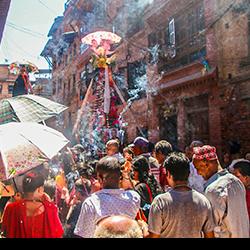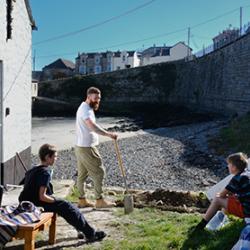The Department of Social Anthropology is delighted to announce the winners in this year’s Postgraduate Photography Celebration.
There was a very high standard and number of entrants this year, reflecting the popularity of this celebration. Since its start in 2013, the celebration provides an opportunity for postgraduate students to showcase their fieldwork photographs and for the Department to celebrate the diversity and richness of research undertaken.
photo by Sally Montgomery photo by Devi Chakrabarti
The prizewinners this year are, in a tie for first place, Sally Montgomery and Devi Chakrabarti, with Christie van Tinteren in second place and in joint third place João Kelmer Caldeira de Andrada and Sarthak Malhotra. All the images can be viewed here and are also linked in this news article by person. We are grateful to all students for submitting their entries, and to all the judges for their considerable time: Naomi Richman, Adam James Smith, and Tim Cooper.
Sally Montgomery’s ethnographic research is concerned with understanding the human-environment encounters on Lord Howe Island, Australia. She writes: ‘The concept of belonging emerged throughout my fieldwork as a key theme relating to both human and non-human life on the Island.’ She considers the notion of belonging as it emerges through practices including ‘pest’ and ‘weed’ eradication; biosecurity protocols; endemic species conservation; environmental tourism; and articulations of kinship-based ‘nativeness’.
The judges’ appreciative comments of Sally’s images included, ‘Montgomery eloquently depicts the qualities of immersion – a conceptual and thematic node important to anthropology and adjacent disciplines in the humanities and social sciences – and in so doing challenges the viewer to think with their bodies’ and ‘These are breathtaking images. I especially like image one for its simplicity, colour, and dream-like quality.’
Devi Chakrabarti’s study explores the unexpected interconnections between devotional life and post-earthquake reconstruction in Bhaktapur, Nepal, one of the world’s most distinctive reconstruction sites, where a Communist municipal government has committed the locality’s resources to the rebuilding of worship sites. Her project is concerned with the remarkable initiatives to rebuild the many structures that were demolished in the 2015 earthquakes, being undertaken in Nepal’s most important centre of spiritual activity and principal international tourist destination.
Commenting on her photographs the judges said, ‘Three beautiful images. In the first, I particularly appreciate the contrast of the energy and movement of the dancer against the stillness of the spectators.’; ‘Chakrabarti’s study of reconstruction as a spiritual project unfolds through these images depicting rites around the renewal and reification of sacred geographies.' and
'Three stunning shots. The contrast of light and shadow in image one is gorgeous, as is the movement of the central figure. I appreciate the lower point of view in image two - it gives the figure a sense of grandeur. Beautifully captured smoke in the street on image three.’
Christie Van Tinteren, awarded second place, has been conducting fieldwork in the town of Newlyn and villages of Paul and Mousehole in the far west of Cornwall. He exams the relationships between industry and identity, processes of memorialisation and nostalgia, and the changing rhythms of life in rural Britain. Alongside of his present-based ethnography, he is also gathering dozens of memoirs and diaries written over the past hundred-and-fifty years by residents of this area. His thesis will knit these elements together to give a richer sense of transformation and enhance his theoretical work.
His images aim to provide insight into the perceived demise of tradition, the desire to support fishers in a town now frequented by tourists, and the corresponding dynamics of housing there. He hopes to convey the vibrancy of the place, showing people engaged in actions which they hope will shape its future.
Of his images the judges said, 'lovely composition, especially way boys are looking out, away from camera and the man who is the focus looks back toward them – plays on themes of past and future. Excellent and evocative descriptions to accompany all three images.' and 'These remarkable, painterly images evince a clearly accomplished photographer with a keen and measured eye towards how images might not only illustrate but also contribute to their work in a sympathetic, engaged, and deeply ethnographic way.'
João Kelmer Caldeira de Andrada's research studies the mortuary ceremonies performed by the Bororo, an indigenous people living in Central Brazil, who employ a complex interplay of senses to evoke the memory of the dead. The three-month-long spectacle of movement, sound, and colour that comprises the ritual cycle mobilises various modes of relation among the living and between the living and the dead. It is precisely these relationships and how they are enacted through singing, ornamentation, food offerings and ritual wailing that form the main subject of his PhD research. Each photo presented was taken during a different phase of the Bororo mortuary cycle and intends to display the centrality of body ornamentation in dealings with the aroe, the Bororo term for ‘dead souls’.
‘In this fascinating study of mortuary practices de Andrada captures intimate moments amid the pomp of ritual.' and ‘A beautiful set of photographs, capturing intimate moments during and in between moments of quite special ritual importance,’ commented the judges.
Sarthak Malhotra’s fieldwork was with people who work and live in Taj Ganj, a neighbourhood in the immediate vicinity of the Taj Mahal in Agra, India. A site of mass tourism and glorious national heritage, this 17th century mausoleum of Mughal royalty is now a fiercely contested symbol of Indian nationhood. What does this place of extraordinary beauty mean to those people who live in its immediate vicinity? How is the Taj Mahal their heritage? Taj Ganj’s residents increasingly contend with a confrontational state that views them as threats to the Taj Mahal’s preservation. Set apart from the neighbourhood the Taj Mahal transforms from a site abundant with social life into a congregation of lifeless stone. He writes: ‘My interlocutors find it untenable that the Taj Mahal be untethered from their daily lives; to them it is always more than a mere monument, it is a site of multiple meanings as a place of private and government employment, the shrine of a benevolent king revered as a Sufi saint, a contested site as a lost temple, and a source of aesthetic pleasure’.
Of Sarthak’s images the judges said, ‘Depicting moments of renovation, rest, and routine Malhotra asks the viewer to consider how the extraordinary becomes ordinary amid a place that is the subject of national contestation.' and ‘I especially enjoyed the second and third photographs. The silhouette of the Taj in the third photo provides an intriguing and less familiar gaze on one of the world’s most famous, and presumably photographed sites. The second photograph captures well the ongoing process of change that goes into making a site appear, indeed, unchangeable. The detail of the broken stone is quite striking.’
Other entrants included: Edurne Sosa El Fakih; Fang Liu; Hairuo Jin: Jenny Tang; Lucia Tremonti; Maria Lartigue-Marin; Radina Kostadinova; Sakari Mesimaki; Shradha Lama; Theo Hughes-Morgan; Theo Stapleton; Xintian Ma; Zoljargal Enkh-Amgalan



